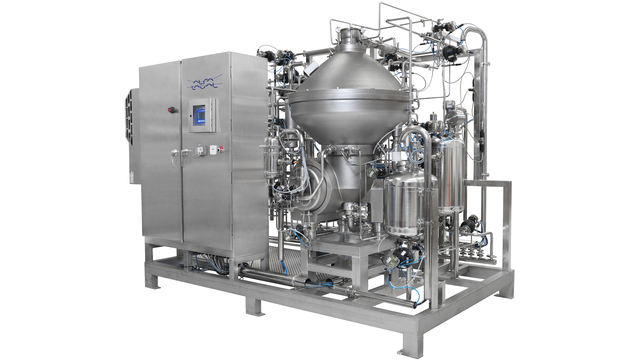Culturefuge
The Alfa Laval Culturefuge is a hermetic cell culture separation system, designed for gentle harvesting of shear-sensitive organisms in applications involving mammalian cell cultures and precipitated proteins.
Gentle product acceleration
The Culturefuge is a specially developed range of separators for gentle treatment of cell cultures and other shear-sensitive biological material. The unique hollow spindle concept enables gentle acceleration of the feed liquid to the rotational speed of the separator, thereby minimizing cell lysis. This prevents the release of unwanted intracellular proteins or minimizes the destruction of fragile protein precipitates. Yields are thus enhanced and downstream operations optimized.
Scalable cell culture separator
Ideal for cell culture fermentation and continuous cell harvesting under hermetic conditions, the Culturefuge separator delivers consistent product quality and can be accurately and reliably scaled up from use in pilot plants to full-scale production.
Airtight cell culture separator
The Culturefuge is a fully hermetic separator, which effectively eliminates any air-liquid interface inside the separator bowl. This prevents air entrainment, which can cause problems in the downstream filtration process. Furthermore, flow control devices can be located downstream thus enabling implementation of an obstruction-free, full-bore feed arrangement.
Hygienic design
Culturefuge is engineered using materials that meet stringent regulatory requirements for processing. To maintain hygienic operating conditions, this cell culture centrifuge can be automatically cleaned and sanitized without requiring major disassembly or assembly using Sterilization-in-Place (SIP) and Cleaning-in-Place (CIP) systems. In addition, flushing nozzles spray outside the centrifuge bowl, cyclone and inside the frame hood for maximum hygiene.
Complete separation system
The Alfa Laval Culturefuge is supplied as a skid-mounted separation system consisting of a disk-stack separator mounted on a fixed base frame with horizontal drive shaft, worm gear, lubricating oil bath and hollow vertical bowl spindle, and piping for service liquids and process liquids. It includes an integrated electrical system with starter, programmable logic control (PLC) system and pneumatic unit.
The design of the cell culture separator is in accordance with most major pressure vessel specifications, including ASME and PED.
Design options
- Superfine electro-polished product contact surface
- Steam-sterilizable pump for transport of the solids phase
- Delivery of skid-mounted unit for open operation, contained running, steam-sterilizable aseptic operation, or steam decontamination-only operation.
The Culturefuge range
- Culturefuge 100 for pilot plants and small-scale production with capacities ranging from 200 to 2,000 l/hr.
- Culturefuge 200 for medium scale production with capacities ranging from 1,000 to 5,000 l/hr.
- Culturefuge 300 for medium to large scale production with capacities ranging from 2,000 to 8,000 l/hr.
- Culturefuge 400 for large scale production with capacities ranging from 5,000 to
20,000 l/hr.
Upon request, Alfa Laval can provide validation support services and a rigorous Factory Acceptance Test (FAT) in our in-house test facility.
Cuturefuge cell centrifuge - Benefits
- Compact and flexible design
- Sterilizable
- CIP (Cleaning-In-Place)-able
- Contained
The Culturefuge concept
Kaip tai veikia
The Culturefuge cell separator provides gentle, fully hermetic treatment of cell cultures and other shear-sensitive biological materials. The biological material enters the cell centrifuge through a hollow spindle feed inlet. It gradually accelerates as it moves upward to the disc stack, where the separation takes place in the rotating centrifuge bowl. The separated liquid phase leaves through the liquid outlet at the top of the bowl. The collected solids in the solid space are intermittently discharged from the periphery of the bowl. During normal production, the operating water keeps the sliding bowl bottom closed against the bowl hood. During discharge, the sliding bowl bottom drops for a short time (less than a second), and the solids are ejected through the discharge ports.

